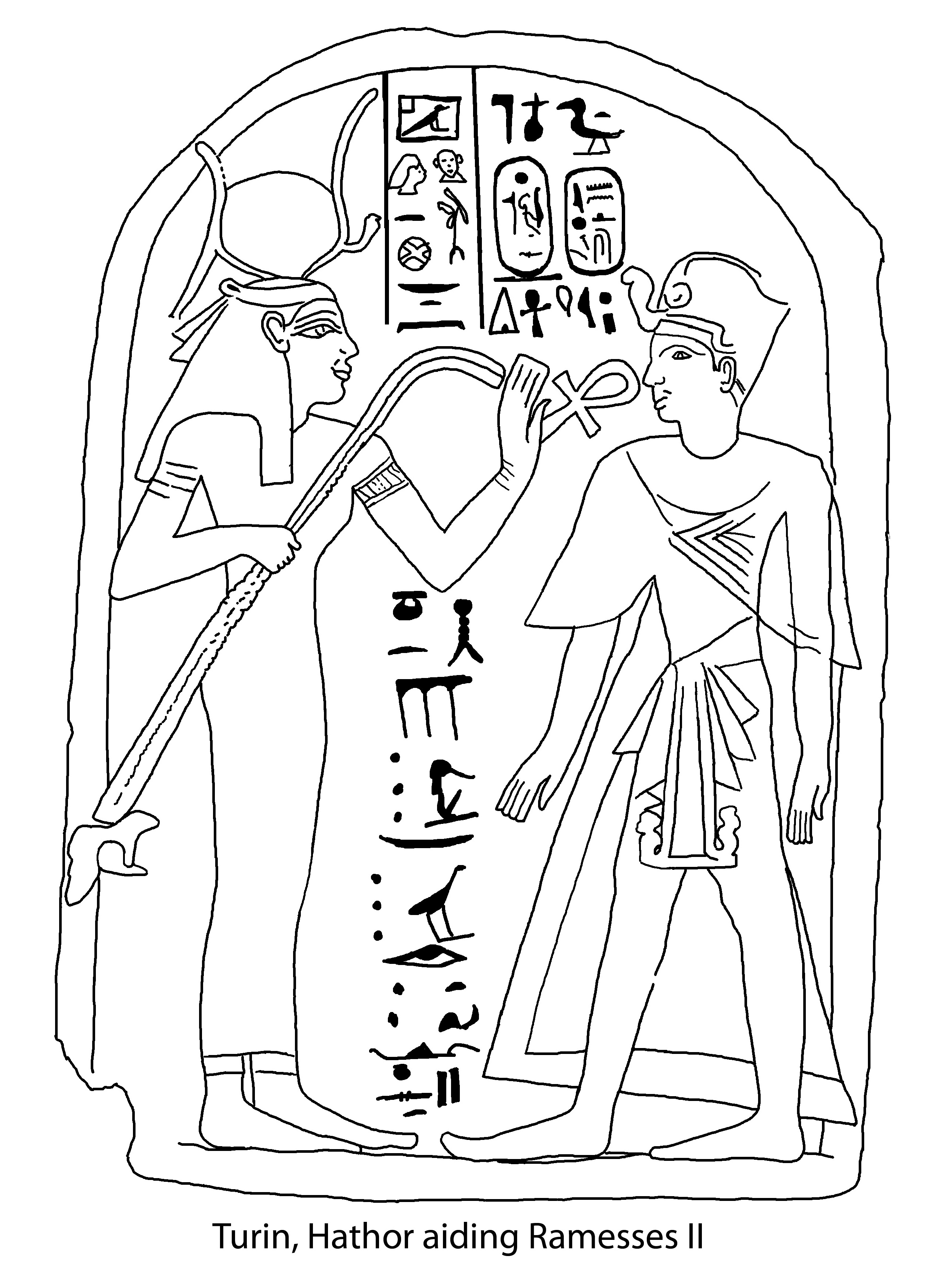
Thursday, August 27, 2015
Two Hathor Sightings And...
2:17pm

Thursday, August 27, 2015
Two Hathor Sightings And...
2:17pm
 Hathor presenting palm branches to Ramesses II Turin museum Reference photos: one by Su Bayfield and another by Margaret aka 'Pling the Penguin' |
|
I admit the artist of this stela wasn't the best. Hathor's ears are too high, the pharaoh's eyes are out of place, and the glyphs aren't very clear. One photographer thought the cartouche could be saying "Amenhotep", while the other ventured "Ramesses II". "Amen" can plainly be seen. But more of the glyphs resemble those of Ramesses, so I'm going with that. Perhaps this piece wasn't commissioned by the pharaoh, who would have employed the best, but by someone less royal, who simply wanted to bless the pharaoh, and took whoever was available. Hathor presents palm branches to the pharaoh, which means "length of time" and "years", thereby ensuring he will have a long reign. The figure at the bottom of the branches is supposed to be a tadpole, meaning "100,000". Also, she offers him the ankh, representing her endowing the pharaoh with life. I found these Hathor name variations when putting "Hathor" into the search parameters at "Ramses Online: an annotated corpus of Late Egyptian". The first two instances are referring to the Seven Hathors, who have influence on destiny. "The seven Hathors appear at the birth of a child and predict the fate of the newly-born. In the famous story of 'the prince and the destiny' they prophesy that the prince shall meet his death through a crocodile, a serpent or a dog. This prophesy, however, does not imply an inevitable fate, but rather designates three evil chances which can perhaps be avoided. The end of the story is missing, but presumably they are avoided because of the prince's courage, his trust in [the Gods} and the love and care of his wife." (From _Hathor and Thoth: Two Key Figures of the Ancient Egyptian Religion_, by Claas Jouco Bleeker, pages 71-72) The first example is from this story, I did read all the way to the end, because I was curious which got the prince, and no one knows now. I'll go with Bleeker's optimistic view, though. The second example is from the Orbiney papyrus at the British museum, EA 10183; The Two Brothers. I didn't read all of it, but learned that the story ends happily, with the brothers Bata and Anpu "at peace with one another and in control of their country". The next two examples are from the Papyrus Chester Beatty, and the last is from the Salt papyrus, all four papyri are at the British Museum. The next Hathor sighting is at the Brooklyn museum. I was able to refer all of the museum's photos to creat my trace: |
 Sistrophoros Statue of Kaemwaset Possibly from Karnak, Thebes New Kingdom, XVIII Dynasty, 1400-1390 B.C.E. Granite, traces of paint Size 26 1/8 x 10 1/4 x 17 13/16in. (66.3 x 26 x 45.3cm) Gift of Christos G. Bastis Brooklyn Museum, #74.97 |
|
( Museum website description: "Black granite statue inscribed for Kaiemwaset. The nobleman is represented as kneeling and proffering a large Hathor-sistrum. Kaiemwaset is dressed in a long skirt. The figure is inscribed on the right shoulder, the back pillar, the front, sides and upper front surface of the base, and on the sides of the mass of stone which connects the sistrum and chest. There is some red pigment preserved in the hieroglyphs on the front of the base. The figure bears the cartouche of Tuthmosis IV. Condition: The head, except for the parts of the wig, neck and beard, is missing. Large chips in the front, right side and rear of base. The left arm, left foot and left side of the base are mostly chipped away: the back pillar is only partially preserved. There are smaller chips in many places, and there is dried mud on much of the surface. "Kaemwaset was connected with the temple of Amun-Re at Karnak in Thebes (modern-day Luxor). The inscription on this statue invokes that god, as well as the goddesses Mut and Nebethetepet. It would have enabled the deceased Kaemwaset to share in the daily temple offerings to the gods and to participate in the daily rites of resurrection. "The royal name carved on Kaemwaset's upper right arm dates his statue to the reign of Thutmose IV. The rolls of flesh on his torso are an artistic convention indicating his prosperity. The object that he holds represents the head of the goddess Hathor resting on a protective Isis-knot. On her head is a miniature temple gateway flanked by two volutes. These forms suggest the sistrum, a musical rattle whose sound was beloved by Hathor and other goddesses. The cobra shown in the doorway and two others on the sides also evoke goddesses and their protection."
I could make out the glyphs for Amun and Mut. What impressed me about this piece is how the head of Hathor grows out of the Tyet knot, more examples here. Also,
there's a spoon with a Hathor head supported by a combination Tyet and Djed at the Berlin museum |
Go Forward...
Go Back to Archives...
Go Back to Main Journal Index Page...
Go to Index of Joan's pages...
![]()
© Joan Ann Lansberry